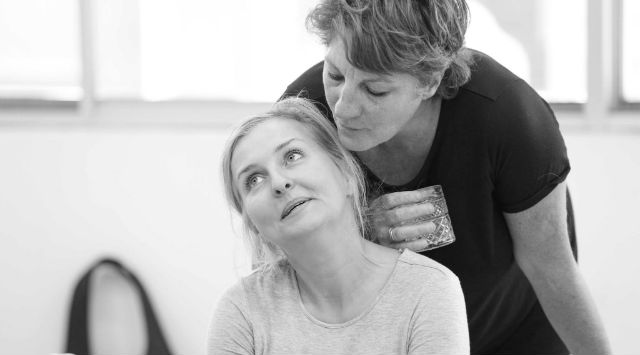 Venue: Belvoir St Theatre (Surry Hills NSW), Feb 13 – Mar 20, 2016
Venue: Belvoir St Theatre (Surry Hills NSW), Feb 13 – Mar 20, 2016
Playwright: Stephen Sewell
Director: Eamon Flack
Cast: Michael Denkha, Ivan Donato, Andrew Henry, Emma Jackson, Russell Kiefel, Genevieve Lemon, Geoff Morrell, Zahra Newman, Dan Spielman, Yael Stone, Ben Wood
Image by Brett Boardman
Theatre review
Stephen Sewell’s The Blind Giant Is Dancing premièred in 1983, long before the internet and social media had become a central part of how we understand and engage in politics. Armchair activism had yet to be discovered, and participation in our country’s big issues required more than clicks on neglected polls and petitions, or furious rants of 140 characters. If any action was to be taken, we had to put money where our mouths were, and the stakes were much higher than risking the closure of troll accounts on Twitter.
The play looks at how the working class was embroiled with trade unions and other organisations in a fight for protecting their rights, at a watershed period where capitalism’s subsumption of the economy was fiercely under way. We watch the moral descent of an idealist in Allen Fitzgerald as he climbs the ladders of power, observing the seemingly inevitable corruption that occurs as an individual finds their way into positions of power. It is a deeply pessimistic and cynical statement about the world that director Eamon Flack has successfully transposed to twenty-first century Australia. Industrial relations continue to be a key issue, and we are probably more aware than ever before, about the vulnerabilities of our democracy. The details in The Blind Giant Is Dancing might be outdated, but its concepts are resolutely relevant, and its ideology remains powerful.
With its zealous political dissections, aficionados would probably find the work irresistible, but there is much in the production that appeals to the layperson. Its central concern regarding tensions between the personal and the political, are fluently expressed, especially in scenes that move the plot into realms of the domestic. Allen’s personal life allows us to relate to his story more intimately, as he negotiates abstract principles and beliefs, against the real matter of daily life. The conflicts that arise from trying to put into being, imagined and utopian ideals for larger social contexts, prove to be problematic as we witness those precepts failing in the Fitzgerald household. It is his broken relationships with family and lovers that we empathise with, and the meanings behind that destruction, which are most poignant.
Dan Spielman is convincing as Allen, with a commanding stage presence that places him comfortably at the centre of all our attention. He connects well with the audience from the start, and we stay compelled until the bitter end. His portrayal of the complex role is intelligent, confident, and quite affecting. Although disappointing, we see his flaws and misjudgements as human, and Spielman’s honesty as a performer helps us realise the accuracy of the grim situation in which we find his character. The role of Louise is played by Yael Stone, sensitive and intricate, with excellent conviction behind the fiery personality being depicted. Louise is perhaps not as well-written a character as her male counterparts, but Stone’s ability to locate emotional authenticity assists with our all-important suspension of disbelief to make her narrative work.
This is a production of high quality, polished and consistently thoughtful. The cast does a marvellous job in creating a succession of explosive scenes that grips us for its entirety (the three-hour duration whizzes past), and the designers impress with adventurous and effective work. Sound design by Steve Toulmin in particular, provides an epic grandeur, recalling period drama pieces of a similar ilk that trace the familiarly ominous ascension of political figures.
The Blind Giant Is Dancing warns us of many things, but provides no solutions. The darkness of its revelations feel real and in spite of their grave severity, we are offered no recourse. What happens after the curtain call is anybody’s guess, and also a crucial estimation about the utility of theatre. The show interrogates all our personal lives, and after receiving its indictments, the process will continue in each individual beyond that evening of attendance. If an artist is unable to produce the answers, the best they can do is to ask the questions, boldly and fervently. What we wish to happen thereafter can only then be, a question of hope.
www.belvoir.com.au
 Venue: Old Fitzroy Theatre (Woolloomooloo NSW), Feb 23 – Mar 4, 2016
Venue: Old Fitzroy Theatre (Woolloomooloo NSW), Feb 23 – Mar 4, 2016

 Venue: King Street Theatre (Newtown NSW), Feb 24 – Mar 4, 2016
Venue: King Street Theatre (Newtown NSW), Feb 24 – Mar 4, 2016 Venue: Sydney Opera House (Sydney NSW), Feb 20 – Mar 27, 2016
Venue: Sydney Opera House (Sydney NSW), Feb 20 – Mar 27, 2016















 Venue: New Theatre (Newtown NSW), Feb 16 – Mar 5, 2016
Venue: New Theatre (Newtown NSW), Feb 16 – Mar 5, 2016 Venue: Belvoir St Theatre (Surry Hills NSW), Feb 13 – Mar 20, 2016
Venue: Belvoir St Theatre (Surry Hills NSW), Feb 13 – Mar 20, 2016 Venue: Blood Moon Theatre (Potts Point NSW), Feb 17 – Mar 4, 2016
Venue: Blood Moon Theatre (Potts Point NSW), Feb 17 – Mar 4, 2016 Venue: SBW Stables Theatre (Kings Cross NSW), Feb 5 – Mar 26, 2016
Venue: SBW Stables Theatre (Kings Cross NSW), Feb 5 – Mar 26, 2016 Venue: Old Fitzroy Theatre (Woolloomooloo NSW), Feb 9 – 20, 2016
Venue: Old Fitzroy Theatre (Woolloomooloo NSW), Feb 9 – 20, 2016